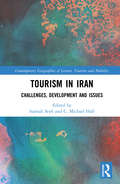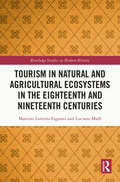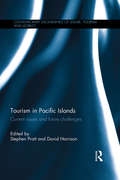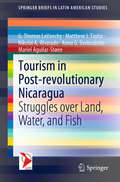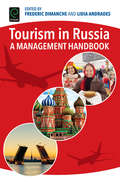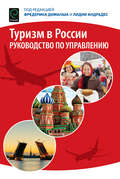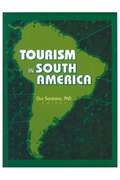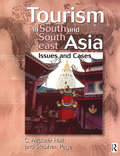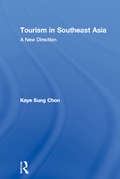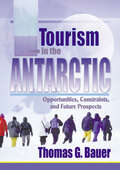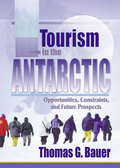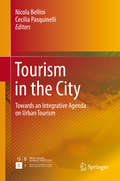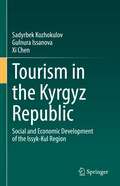- Table View
- List View
Tourism in Iran: Challenges, Development and Issues (Contemporary Geographies of Leisure, Tourism and Mobility)
by C. Michael Hall Siamak SeyfiIran has long been regarded as an international pariah state in some parts of the international community. However, its negative image in many countries disguises its history of tourism and rich cultural and natural heritage. Following the July 2015 nuclear deal and the reduction in sanctions, Iran is focusing on international tourism as a means to generate economic growth in addition to its substantial domestic tourism market. Given the significance of tourism in the Middle East and in international politics, as well as restrictions on international mobility, this volume brings together the first contemporary collection of research on tourism in Iran. Written by experts based both within and outside of Iran, the chapters engage with a number of crucial issues including the importance of religion, the role of women in society, sustaining Iran’s cultural heritage, Iran’s image and the resistive economy to provide a benchmark assessment of tourism and its potential future in a troubled political environment. The book will undoubtedly be of interest not only to those readers who focus specifically on Iran but also those who seek a wider understanding of Iran’s role in the region and how tourism is utilised as part of national and regional economic development policies.
Tourism in Iran: Challenges, Development and Issues (Contemporary Geographies of Leisure, Tourism and Mobility)
by Siamak Seyfi C. Michael HallIran has long been regarded as an international pariah state in some parts of the international community. However, its negative image in many countries disguises its history of tourism and rich cultural and natural heritage. Following the July 2015 nuclear deal and the reduction in sanctions, Iran is focusing on international tourism as a means to generate economic growth in addition to its substantial domestic tourism market. Given the significance of tourism in the Middle East and in international politics, as well as restrictions on international mobility, this volume brings together the first contemporary collection of research on tourism in Iran. Written by experts based both within and outside of Iran, the chapters engage with a number of crucial issues including the importance of religion, the role of women in society, sustaining Iran’s cultural heritage, Iran’s image and the resistive economy to provide a benchmark assessment of tourism and its potential future in a troubled political environment. The book will undoubtedly be of interest not only to those readers who focus specifically on Iran but also those who seek a wider understanding of Iran’s role in the region and how tourism is utilised as part of national and regional economic development policies.
Tourism in Natural and Agricultural Ecosystems in the Eighteenth and Nineteenth Centuries (Routledge Studies in Modern History)
by Martino Lorenzo Fagnani Luciano MaffiThis book analyzes the roots of one of the main human activities that can be developed in natural and agricultural ecosystems: tourism. Attention to natural and agricultural ecosystems and their conservation has intensified in recent decades, responding to increasing social sensitivity to the environment, as also witnessed by Agenda 2030. The book explores the development of tourism in natural and agricultural ecosystems in the eighteenth and nineteenth centuries, when some of its essential features derived from the practices of exploration, scientific study, business, healing practices, and also a desire for personal growth. This research is intended to open up international scholarly debate and discussion and draw in contributions from all disciplines and geographical areas. In addition, it intends to add an important piece to the mosaic of international literature that has rarely considered the origins of nature and rural tourism in an array of practices not always embodying a stated intent of recreation. This book is based on handwritten documents and travelogues circulating during the period in question. Most of the travel experiences analyzed regard men and women of European descent, but their travels were global, with ecosystems considered on all populated continents. This volume is essential reading for students and scholars alike interested in tourism history and the history of science and travel.
Tourism in Natural and Agricultural Ecosystems in the Eighteenth and Nineteenth Centuries (Routledge Studies in Modern History)
by Martino Lorenzo Fagnani Luciano MaffiThis book analyzes the roots of one of the main human activities that can be developed in natural and agricultural ecosystems: tourism. Attention to natural and agricultural ecosystems and their conservation has intensified in recent decades, responding to increasing social sensitivity to the environment, as also witnessed by Agenda 2030. The book explores the development of tourism in natural and agricultural ecosystems in the eighteenth and nineteenth centuries, when some of its essential features derived from the practices of exploration, scientific study, business, healing practices, and also a desire for personal growth. This research is intended to open up international scholarly debate and discussion and draw in contributions from all disciplines and geographical areas. In addition, it intends to add an important piece to the mosaic of international literature that has rarely considered the origins of nature and rural tourism in an array of practices not always embodying a stated intent of recreation. This book is based on handwritten documents and travelogues circulating during the period in question. Most of the travel experiences analyzed regard men and women of European descent, but their travels were global, with ecosystems considered on all populated continents. This volume is essential reading for students and scholars alike interested in tourism history and the history of science and travel.
Tourism in Pacific Islands: Current Issues and Future Challenges (Contemporary Geographies of Leisure, Tourism and Mobility)
by Stephen Pratt David HarrisonPacific Island Countries have been shown to be especially vulnerable to such external influences as natural disasters, political unrest and downturns in the global economy and their tourism industries have been notably affected. In particular, they typically have a narrow resource base and a fragile and often vulnerable natural environment. While there is some research on islands and small states, there is a dearth of information on the South Pacific and very little research is being undertaken in the region compared to other geographical regions in the world. This volume brings together current work in Pacific Island tourism. In this collection, three main themes arise: Images of the South Pacific; Socio-economic Impacts of Tourism; and Pacific Island Countries and the Outside World. The first focus is on the question of image, namely, stereotypes of a destination held by tourists and potential tourists, the extent to which residents, for their part, really welcome visitors, and the role tourism might play in changing pre-established images. The second theme is tourism's impacts, notably the economic and socio-cultural effects of international tourism's intrusion in the region which, though often hotly debated, have attracted relatively little empirical research. The third focus is on the challenges of how PICs articulate with their external geo-political and physical environment. These involve existing relations with formal colonial centres, geographical isolation, the need for greater air access to the outside world and for more tourists, and the continuing threat to several PICs of global warming, which increased air travel will inevitably exacerbate. This text will be of interest to tourism students, researchers and academics in the fields of tourism, development studies and cultural studies.
Tourism in Pacific Islands: Current Issues and Future Challenges (Contemporary Geographies of Leisure, Tourism and Mobility)
by Stephen Pratt David HarrisonPacific Island Countries have been shown to be especially vulnerable to such external influences as natural disasters, political unrest and downturns in the global economy and their tourism industries have been notably affected. In particular, they typically have a narrow resource base and a fragile and often vulnerable natural environment. While there is some research on islands and small states, there is a dearth of information on the South Pacific and very little research is being undertaken in the region compared to other geographical regions in the world. This volume brings together current work in Pacific Island tourism. In this collection, three main themes arise: Images of the South Pacific; Socio-economic Impacts of Tourism; and Pacific Island Countries and the Outside World. The first focus is on the question of image, namely, stereotypes of a destination held by tourists and potential tourists, the extent to which residents, for their part, really welcome visitors, and the role tourism might play in changing pre-established images. The second theme is tourism's impacts, notably the economic and socio-cultural effects of international tourism's intrusion in the region which, though often hotly debated, have attracted relatively little empirical research. The third focus is on the challenges of how PICs articulate with their external geo-political and physical environment. These involve existing relations with formal colonial centres, geographical isolation, the need for greater air access to the outside world and for more tourists, and the continuing threat to several PICs of global warming, which increased air travel will inevitably exacerbate. This text will be of interest to tourism students, researchers and academics in the fields of tourism, development studies and cultural studies.
Tourism in Post-revolutionary Nicaragua: Struggles over Land, Water, and Fish (SpringerBriefs in Latin American Studies)
by G. Thomas LaVanchy Matthew J. Taylor Nikolai A. Alvarado Anna G. Sveinsdóttir Mariel Aguilar-StøenThis book interrogates the impact of tourism on local lives and environments along the southern Pacific Coast of Nicaragua. Nicaragua has turned to tourism to earn needed foreign exchange and to provide jobs. The unplanned boom, however, has come with costs to local environments. Using an in-depth case study of the community of Gigante and nearby tourism developments, the chapters delve into the impact of recent unregulated booms in tourism on groundwater, household water security, local economies, culture, land ownership, and artisanal fisheries.
Tourism in Russia: A Management Handbook
by Lidia Andrades Frederic DimancheRussia, the largest country in the world, has untapped tourism potential. Historic and cultural resources, natural attractions, and business opportunities attract a growing number of visitors to this fast-growing country. The book will appeal to a broad base of students, professors, and practitioners. It addresses tourism as a system, provides essentials of management and marketing, discusses tourism planning and impact management, and proposes strategies and recommendations to improve Russia as an international destination. It is also unique in its approach: it has been written by a group of collaborating authors as part of an EU-funded project that created links between tourism academics from Russia and the European Union. Each chapter was co-written by an international mix of contributors who have worked together on tourism and Russia for two years. This project has been funded with support from the European Commission. It reflects the views only of the authors, and the Commission cannot be held responsible for any use which may be made of the information contained therein.
Tourism in Russia: A Management Handbook (Russian Translation)
by Frederic Dimanche Lidia AndradesRussia, the largest country in the world, has untapped tourism potential. Historic and cultural resources, natural attractions, and business opportunities attract a growing number of visitors to this fast-growing country. The book will appeal to a broad base of students, professors, and practitioners. It addresses tourism as a system, provides essentials of management and marketing, discusses tourism planning and impact management, and proposes strategies and recommendations to improve Russia as an international destination. It is also unique in its approach: it has been written by a group of collaborating authors as part of an EU-funded project that created links between tourism academics from Russia and the European Union. Each chapter was co-written by an international mix of contributors who have worked together on tourism and Russia for two years. This project has been funded with support from the European Commission. It reflects the views only of the authors, and the Commission cannot be held responsible for any use which may be made of the information contained therein.
Tourism in South America
by Gui SantanaDevelop the untapped possibilities of this potential tourist El Dorado!Given its size, location, cultural attractions, and natural beauty, South America gets far less of the international tourist dollar than it deserves. This valuable book identifies and explores the major issues that influence and shape tourism in South America. Tourism in South America includes original empirical research into the image people have of this varied continent, the factors that draw people to visit South America, and the fears, lack of knowledge, and negative images that can keep tourists away.Tourism in South America examines current practices and suggests alternative models of development. Its informative discussions range from cultural tourism to sustainable tourism to developing human resources. The original empirical research in this volume offers unique insights, and reference notes are included.The reader will encounter varied points of view in Tourism in South America. You can expect to: view Australian travel industry perspectives on Latin American tourism explore the impact of tourism on the Argentina's Patagonian Coast examine the environmental tactics that Mexican and Jamaican hotel companies employ survey the recreation preferences of hikers in a Colombian National Park ponder the implications of performing traditional dances for modern tourists in the AmazonTour operators, hotel managers, local tourism boards, and others seeking the attention of tourists will profit from the new strategies and original research presented in Tourism in South America.
Tourism in South America
by Gui SantanaDevelop the untapped possibilities of this potential tourist El Dorado!Given its size, location, cultural attractions, and natural beauty, South America gets far less of the international tourist dollar than it deserves. This valuable book identifies and explores the major issues that influence and shape tourism in South America. Tourism in South America includes original empirical research into the image people have of this varied continent, the factors that draw people to visit South America, and the fears, lack of knowledge, and negative images that can keep tourists away.Tourism in South America examines current practices and suggests alternative models of development. Its informative discussions range from cultural tourism to sustainable tourism to developing human resources. The original empirical research in this volume offers unique insights, and reference notes are included.The reader will encounter varied points of view in Tourism in South America. You can expect to: view Australian travel industry perspectives on Latin American tourism explore the impact of tourism on the Argentina's Patagonian Coast examine the environmental tactics that Mexican and Jamaican hotel companies employ survey the recreation preferences of hikers in a Colombian National Park ponder the implications of performing traditional dances for modern tourists in the AmazonTour operators, hotel managers, local tourism boards, and others seeking the attention of tourists will profit from the new strategies and original research presented in Tourism in South America.
Tourism in South and Southeast Asia
by C. Michael Hall Stephen Page'Tourism in South and South East Asia' is a comprehensive and solid introduction to tourism in South and South East Asia with a specific appeal both to institutions in the region, and other institutions who wish to expose students to one of the most dynamic tourism regions in the world. Despite downturns in outbound tourism (due to the current economic crisis), inbound tourism from outside the region has continued to increase with governments placing more emphasis on the economic significance of tourism than ever. 'Tourism in South and South East Asia' is the first tourism book to deal comprehensively with the implications of the Asian economic crisis for tourism.With South and South East Asia set to be the fastest growing area of tourism activity in the world well into the next century, 'Tourism in South and South East Asia' is an essential text for students both within and outside of this region.Dealing with concepts, themes and issues which are pertinent to tourism development, planning, marketing and management; these two internationally known authors have produced an authoritative text that covers all aspects of this topic through the use of illustrative and relevant case studies.
Tourism in South and Southeast Asia
by C. Michael Hall Stephen Page'Tourism in South and South East Asia' is a comprehensive and solid introduction to tourism in South and South East Asia with a specific appeal both to institutions in the region, and other institutions who wish to expose students to one of the most dynamic tourism regions in the world. Despite downturns in outbound tourism (due to the current economic crisis), inbound tourism from outside the region has continued to increase with governments placing more emphasis on the economic significance of tourism than ever. 'Tourism in South and South East Asia' is the first tourism book to deal comprehensively with the implications of the Asian economic crisis for tourism.With South and South East Asia set to be the fastest growing area of tourism activity in the world well into the next century, 'Tourism in South and South East Asia' is an essential text for students both within and outside of this region.Dealing with concepts, themes and issues which are pertinent to tourism development, planning, marketing and management; these two internationally known authors have produced an authoritative text that covers all aspects of this topic through the use of illustrative and relevant case studies.
Tourism in Southeast Asia: A New Direction
by Kaye Sung ChonMake the most of the potential for tourism and hospitality in Southeast Asia!Tourism is known as the world's fastest growing industry, but until now there has been precious little published on the industry as it relates to Southeast Asia and Indo-China. Tourism in Southeast Asia: A New Direction focuses on the remarkable growth in international tourism seen in that region in recent years. Some of the topics explored in Tourism in Southeast Asia: A New Direction are: cross-border cooperation ecotourism opportunities for local communities existing tourism organizations the vulnerability of current tourism policies and suggestions for change the impacts of tourism on local communities the flow of tourism between Australia and Southeast Asia collaborative tourism marketing the growth and development of the cruise line industry in Southeast AsiaWhile the state of the industry's growth and development varies greatly from one country in the region to another, all face the challenge of fostering financially and environmentally sustainable tourism. This volume sheds light on the confusing issues of tourism development, marketing, and management in Southeast Asia and Indo-China.Here is the essential guide to the exploding tourism and hospitality industries in Southeast Asia and Indo-China. You will discover unique cultural aspects of various countries in the region and the impact they can have on tourism and hospitality, as well as industry overviews and current and anticipated trends.
Tourism in Southeast Asia: A New Direction
by Kaye Sung ChonMake the most of the potential for tourism and hospitality in Southeast Asia!Tourism is known as the world's fastest growing industry, but until now there has been precious little published on the industry as it relates to Southeast Asia and Indo-China. Tourism in Southeast Asia: A New Direction focuses on the remarkable growth in international tourism seen in that region in recent years. Some of the topics explored in Tourism in Southeast Asia: A New Direction are: cross-border cooperation ecotourism opportunities for local communities existing tourism organizations the vulnerability of current tourism policies and suggestions for change the impacts of tourism on local communities the flow of tourism between Australia and Southeast Asia collaborative tourism marketing the growth and development of the cruise line industry in Southeast AsiaWhile the state of the industry's growth and development varies greatly from one country in the region to another, all face the challenge of fostering financially and environmentally sustainable tourism. This volume sheds light on the confusing issues of tourism development, marketing, and management in Southeast Asia and Indo-China.Here is the essential guide to the exploding tourism and hospitality industries in Southeast Asia and Indo-China. You will discover unique cultural aspects of various countries in the region and the impact they can have on tourism and hospitality, as well as industry overviews and current and anticipated trends.
Tourism in the Antarctic: Opportunities, Constraints, and Future Prospects
by Thomas BauerEcotourism and adventure tours offer unique tourism opportunities in the Antarctic! Are you prepared to make the most of them?Tourism in the Antarctic analyzes tourism activities in the most remote tourist destination in the world! It establishes visitor profiles; discusses the impacts of tourism on the region; and explores barriers, opportunities, and future directions in Antarctic tourism. The emergence of ecotourism has turned Antarctica into an increasingly popular tourist destination for intrepid travelers. During the 1999/2000 season, approximately 15,000 passengers visited Antarctica by ship. Tourism in the Antarctic discusses the new and exciting opportunities for tourism business operators in the region, as well as the ramifications of increased numbers of visitors to this unique environment.In these pages, you will find discussions of issues related to Antarctic tourism including: regulation of the tourism industry under the Antarctic Treaty System, and self-regulation provided by business operators trends and predictions for numbers of visitors to the region tourist attractions that are natural, man-made, spiritual, or scientific in nature wildlife of Antarctica: seals and whales, flying sea birds, penguins, etc. international law as it relates to the region ship-based tourism opportunities from yachts and small expedition-type vessels to very large cruise ships and icebreakers air- and land-based tourism opportunities in the region from private expeditions to overflights an overview of current tourism operations in other remote areas: the Arctic region, the Galapagos Islands, Alaska, New Zealand's Sub-Antarctic Islands, and moreThe author's observations and experiences during cruises to the Antarctic Peninsula, the sub-Antarctic islands and the Ross Sea, as well as during overflights of Antarctica, are the basis of this unique volume. Generously embellished with charts and tables that make it easy to track activities, opinions, trends, and environmental statistics, this book is an essential reference for anyone teaching, studying, or planning to operate a tourism business in this part of the world.
Tourism in the Antarctic: Opportunities, Constraints, and Future Prospects
by Thomas BauerEcotourism and adventure tours offer unique tourism opportunities in the Antarctic! Are you prepared to make the most of them?Tourism in the Antarctic analyzes tourism activities in the most remote tourist destination in the world! It establishes visitor profiles; discusses the impacts of tourism on the region; and explores barriers, opportunities, and future directions in Antarctic tourism. The emergence of ecotourism has turned Antarctica into an increasingly popular tourist destination for intrepid travelers. During the 1999/2000 season, approximately 15,000 passengers visited Antarctica by ship. Tourism in the Antarctic discusses the new and exciting opportunities for tourism business operators in the region, as well as the ramifications of increased numbers of visitors to this unique environment.In these pages, you will find discussions of issues related to Antarctic tourism including: regulation of the tourism industry under the Antarctic Treaty System, and self-regulation provided by business operators trends and predictions for numbers of visitors to the region tourist attractions that are natural, man-made, spiritual, or scientific in nature wildlife of Antarctica: seals and whales, flying sea birds, penguins, etc. international law as it relates to the region ship-based tourism opportunities from yachts and small expedition-type vessels to very large cruise ships and icebreakers air- and land-based tourism opportunities in the region from private expeditions to overflights an overview of current tourism operations in other remote areas: the Arctic region, the Galapagos Islands, Alaska, New Zealand's Sub-Antarctic Islands, and moreThe author's observations and experiences during cruises to the Antarctic Peninsula, the sub-Antarctic islands and the Ross Sea, as well as during overflights of Antarctica, are the basis of this unique volume. Generously embellished with charts and tables that make it easy to track activities, opinions, trends, and environmental statistics, this book is an essential reference for anyone teaching, studying, or planning to operate a tourism business in this part of the world.
Tourism in the Caribbean: Trends, Development, Prospects (Contemporary Geographies of Leisure, Tourism and Mobility)
by David Timothy DuvalThe Caribbean is one of the premier tourist destinations in the world. Changes in travel patterns, markets and traveller motivations have brought about considerable growth and dramatic change to the region's tourism sector. This book brings together a high calibre team of international researchers to provide an up-to-date assessment of the scope of tourism and the nature of tourism development in the Caribbean. Divided into three parts, the book: gives an overview of existing tourism trends in the region addresses tourism development issues, including sustainability, ecotourism, heritage tourism, community participation, management implications, and linkages with agriculture considers future trends, including an assessment of recent world events and their impacts on tourism in the region, and future trends in terms of airlift, economic sustainability and markets. A valuable resource for students of tourism and Caribbean studies, as well as governments, and national and regional tourism offices, this topical volume brings together excellent contributions to assess and analyze the state of the Caribbean tourism; past, present and future.
Tourism in the Caribbean: Trends, Development, Prospects (Contemporary Geographies of Leisure, Tourism and Mobility #Vol. 3)
by David Timothy DuvalThe Caribbean is one of the premier tourist destinations in the world. Changes in travel patterns, markets and traveller motivations have brought about considerable growth and dramatic change to the region's tourism sector. This book brings together a high calibre team of international researchers to provide an up-to-date assessment of the scope of tourism and the nature of tourism development in the Caribbean. Divided into three parts, the book: gives an overview of existing tourism trends in the region addresses tourism development issues, including sustainability, ecotourism, heritage tourism, community participation, management implications, and linkages with agriculture considers future trends, including an assessment of recent world events and their impacts on tourism in the region, and future trends in terms of airlift, economic sustainability and markets. A valuable resource for students of tourism and Caribbean studies, as well as governments, and national and regional tourism offices, this topical volume brings together excellent contributions to assess and analyze the state of the Caribbean tourism; past, present and future.
Tourism in the City: Towards an Integrative Agenda on Urban Tourism
by Nicola Bellini Cecilia PasquinelliThis book critically explores the interconnections between tourism and the contemporary city from a policy-oriented standpoint, combining tourism perspectives with discussion of urban models, issues, and challenges. Research-based analyses addressing managerial issues and evaluating policy implications are described, and a comprehensive set of case studies is presented to demonstrate practices and policies in various urban contexts. A key message is that tourism policies should be conceived as integrated urban policies that promote tourism performance as a means of fostering urban quality and the well-being of local communities, e.g., in terms of quality spaces, employment, accessibility, innovation, and learning opportunities. In addition to highlighting the significance of urban tourism in relation to key urban challenges, the book reflects on the risks and tensions associated with its development, including the rise of anti-tourism movements as a reaction to touristification, cultural commodification, and gentrification. Attention is drawn to asymmetries in the costs and benefits of the city tourism phenomenon, and the supposedly unavoidable trade-off between the interests of residents and tourists is critically questioned.
Tourism in the Green Economy
by Maharaj Vijay Reddy Keith WilkesThe concept of the green economy has now entered mainstream policy debates and been endorsed by a range of United Nations and other organizations. The Rio+20 UN conference specifically drew attention to the green economy approach in the context of sustainable development to move away from business-as-usual practices, act to end poverty, address environmental destruction and build a bridge to the sustainable future. It is increasingly recognized that the tourism sector can make a major contribution to the green economy through more sustainable practices, climate change mitigation and ecotourism. The role of tourism sector will continue to be crucial in the post-2015 sustainable development agenda too. However, there are ambiguities about how tourism and allied industries can maximize their contribution to human well-being and ensure environmentally sustainability, embracing issues of political economy, geography and business ethics. In this context, this book provides consensus about what the green economy entails, what role tourism can play in a green economy, early responses from many countries, on-going and emerging research initiatives that will enable tourism’s transition to a green economy. The chapters address three key themes: understanding the Green Economy concept and the role of tourism; responses and initiatives in greening tourism; and emerging techniques and research implications. A wide range of case studies from around the world and in different contexts is included to demonstrate the extent of the challenge and range of opportunities for the tourism industry.
Tourism in the Green Economy
by Maharaj Vijay Reddy Keith WilkesThe concept of the green economy has now entered mainstream policy debates and been endorsed by a range of United Nations and other organizations. The Rio+20 UN conference specifically drew attention to the green economy approach in the context of sustainable development to move away from business-as-usual practices, act to end poverty, address environmental destruction and build a bridge to the sustainable future. It is increasingly recognized that the tourism sector can make a major contribution to the green economy through more sustainable practices, climate change mitigation and ecotourism. The role of tourism sector will continue to be crucial in the post-2015 sustainable development agenda too. However, there are ambiguities about how tourism and allied industries can maximize their contribution to human well-being and ensure environmentally sustainability, embracing issues of political economy, geography and business ethics. In this context, this book provides consensus about what the green economy entails, what role tourism can play in a green economy, early responses from many countries, on-going and emerging research initiatives that will enable tourism’s transition to a green economy. The chapters address three key themes: understanding the Green Economy concept and the role of tourism; responses and initiatives in greening tourism; and emerging techniques and research implications. A wide range of case studies from around the world and in different contexts is included to demonstrate the extent of the challenge and range of opportunities for the tourism industry.
Tourism in the Kyrgyz Republic: Social and Economic Development of the Issyk-Kul Region
by Sadyrbek Kozhokulov Gulnura Issanova Xi ChenThis book aims to identify the impact of tourism on social and economic development in the Issyk-Kul region of Kyrgyzstan, and to predict the development of the tourism industry and identify any limiting factors for the development of the tourism industry in the Republic as a whole. The impacts of tourism on the region have been poorly understood since the country gained independence in 1991, and so improved methods for identifying and increasing the contribution of the tourism industry to the economic and social development of the region are needed. The book assesses the impact of tourism on the socio-economic situation in the Issyk-Kul region is assessed on the basis of statistical modelling and GIS mapping, provides a comparative analysis of the categories and types of tourism in the regions of the Republic, in particular in the Issyk-Kul region, and identifies factors that have a negative impact on the country’s tourism potential, as well as the shortcomings and prospects for future development. The book's primary audience will be scholars and researchers whose research focuses on the socio-economic impacts of tourism, as well as students and planners. It is expected that it will become a source of information and inspiration for all readers who feel responsible for initiating sustainable development and sustainable use of tourism resources in Kyrgyzstan and other countries.
Tourism in the Muslim World (Bridging Tourism Theory and Practice #2)
by Noel Scott Jafar Jafari Lipping A. Cai"Tourism in the Muslim World" provides a synthesis of thought on an influential current issue for tourism and indeed for our times, and a point of focus for tourism researchers, managers and developers in countries such as the United Arab Emirates, Jordan, Egypt, Maldives and Turkey, as well as the Western world, eager to increase their share in this 1.5 billion strong tourist market. Its chapters raise conceptual, practical, and thought-provoking issues for the wider tourism community as it deals with the growth of new markets and destinations in a globalized economy. This collection of culturally and geographically diverse papers feature both Muslim and non-Muslim (country) insights on this international theme. It draws on contributions from a variety of disciplinary perspectives such as law, theology, business, tourism development, sociology, anthropology, and more. "Tourism in the Muslim World" is the second title in Emerald's new book series "Bridging Tourism Theory and Practice" and will appeal to researchers and research students in the social science and management disciplines, as well as to tourism and hospitality professionals with an interest in the Muslim market.
Tourism in the New Europe
by Rhodri Thomas Marcjanna AugustynThe book represents a state of the art review of key research on small firms in tourism in relation to European integration. It is, therefore, an essential resource for those engaged in research relating to tourism SMEs in transitional economies throughout the world. In addition, it is an essential purchase for the increasing number of students studying modules on small businesses as part of their final year undergraduate and postgraduate degree programmes. One of the key features of this book is its clear focus on breaking new ground by reporting recent research and theorising on small firms in tourism. In many cases, the analysis provided by contributors will carefully relate small business behaviour to issues of wider concern to tourism academics and policy-makers. It is also distinctive for its overt emphasis on contrasting European experiences. These characteristics contrast with the existing literature on small firms in tourism and hospitality, particularly in Europe. Previous literature achieved their aims by providing valuable syntheses of existing literature. Now that such 'taking of stock' has been undertaken, there is a demand for more overtly research-based texts that are nevertheless accessible to a wide audience. This book does exactly that.
